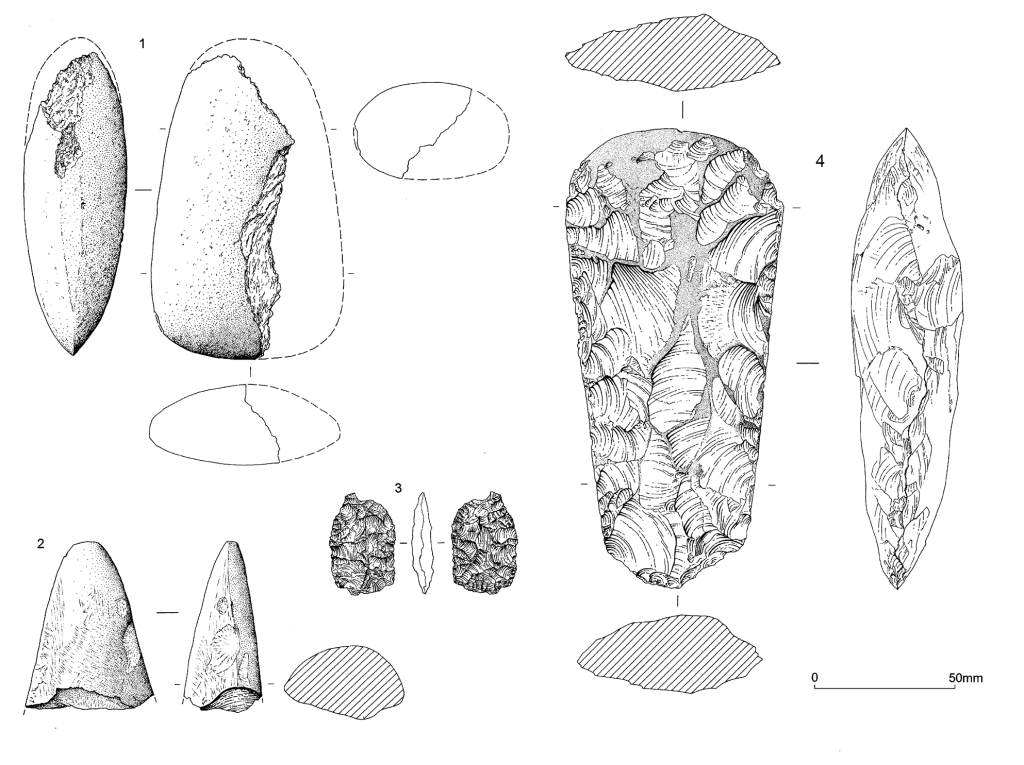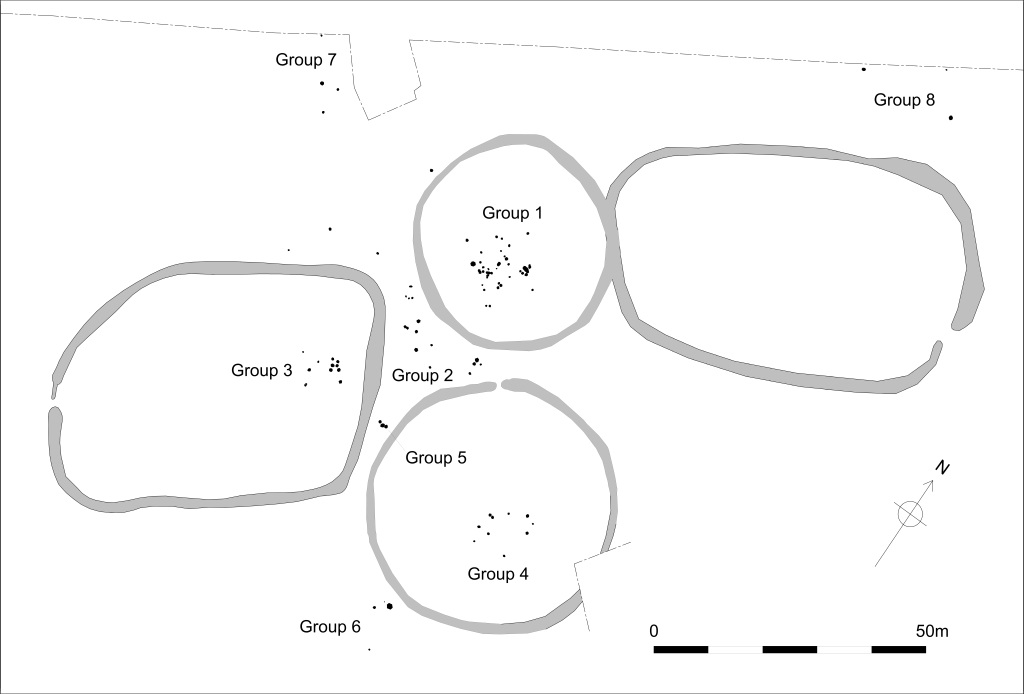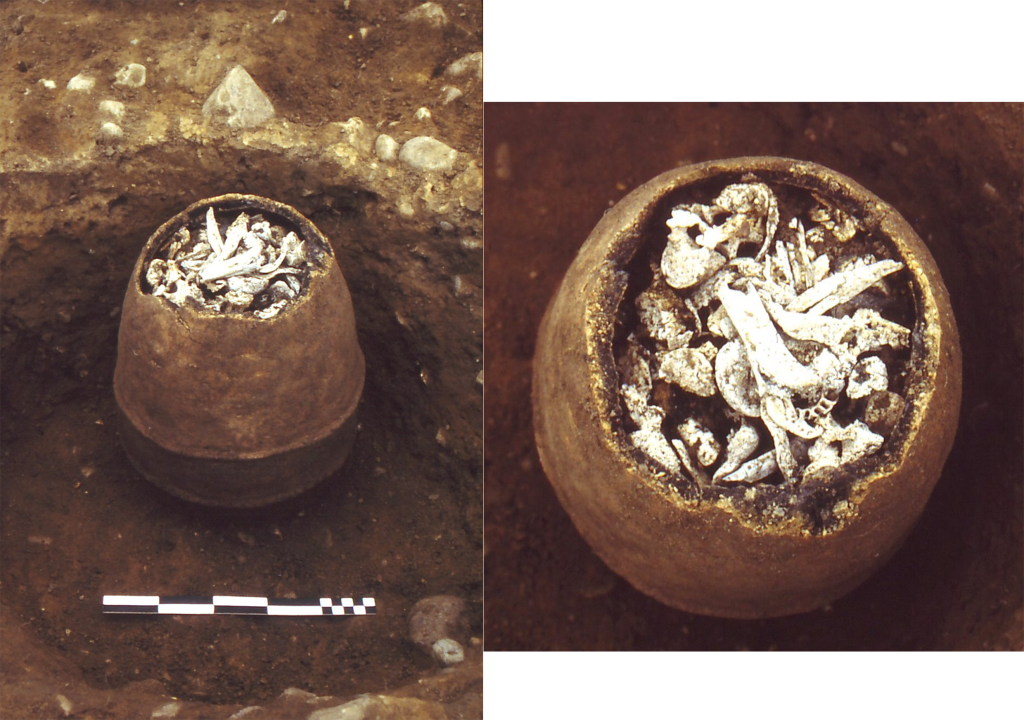One of ULAS’s first major excavations was a large multi-period site at Eye Kettleby near Melton Mowbray in Leicestershire. A new book detailing the important Anglo-Saxon discoveries is soon to be released. To celebrate this, Dr Gavin Speed, Project Manager at ULAS, looks back at the equally significant prehistoric discoveries from the site.
Mesolithic and Neolithic Landuse
The site at Eye Kettleby, in the valley-side had a long history of use prior to the establishment of the Anglo-Saxon settlement. The earliest documented human activity consisted of Mesolithic exploitation, seemingly in a woodland clearing close to a carr (a pond or area of marshy ground). This was evidenced by a large lithics assemblage, and a few features. Another small pit contained sherds of an earlier Neolithic Decorated bowl, whilst a larger pit, possibly representing the remains of a structure, contained sherds of a Late Neolithic Grooved Ware cup and a sizeable flint assemblage. Two very similar large pits located close together in the west of the site produced a group of Late Neolithic/Early Bronze Age flints. These may have been graves in which inhumation burials were interred. A complete flint axe recovered from the carr in the south-west of the site was probably a votive offering deliberately deposited in this watery context. Three other stone axe fragments were recovered from later contexts, one of these from a pit on the edge of the carr, and it seems likely that these were also placed deposits. Cumulatively this evidence points to the site being a significant locale associated with a range of activities that was repeatedly revisited over a long period of time.

Early Bronze Age Funerary/ Ceremonial Monuments
These repeated frequentations might have rendered the clearing a special, revered place, and since in the early Bronze Age, the area was transformed into a monumental ritual landscape.
In the Early Bronze Age a series of ditch-defined monuments was constructed, comprising a pair of closely-spaced ring ditches flanked by two D-shaped enclosures. These were associated with funerary and attendant ceremonial activities. Crop-mark evidence for at least two other ring ditches in the field immediately to the north indicates that the excavated features formed part of a more extensive monument complex. Radiocarbon dating of cremation burials and related deposits provides a chronological framework and serves to clarify the relationship between this phase of activity and the subsequent reuse of the monuments in the Middle Bronze Age.

The complex displayed an unusual symmetry, with opposing pairs of large ring ditches and D-shaped enclosures. These monuments became a focus for evolving ritual burials of special deposits, cremated human remains – urned and unurned – and cremation pyre deposits.

Monument Re-use: Early to Middle Bronze Age ‘Urnfield’ Cemetery
The Early Bronze Age monument complex became the focus for a cremation cemetery that was in use for a period of between two and four centuries, spanning the transition from the Early Bronze Age to the Middle Bronze Age. Some 86 cremation burials or burial-related features are attributable to this episode of activity. These included urned and unurned cremation burials and formalised deposits of pyre debris. No pyre sites were identified, although scorching of the sides of the grave pit in several instances, resulting from the deposition of cremated bone and/or pyre debris whilst still hot, demonstrates that pyres must have been located in the immediate vicinity.

The burials occurred in a number of discrete spatial groups. Variations in depositional practice were apparent between some of these groups and two distinct ceramic traditions were identified amongst the burial urns. A scientific dating programme was devised with the aim of elucidating the chronological development of the cemetery.



Late Bronze Age Landscape, Settlement and Burial
Later in the Bronze Age the landscape was reorganised with the construction of two pit alignment boundaries. Pit Alignment 2 cut through the southern ring ditch and the western D-shaped enclosure. A settlement was established on the site in the Late Bronze Age; this included the remains of one roundhouse, a dispersed group of pits, post-holes, and a hearth. A rectilinear post-built structure located within one corner of a probable enclosure may have been associated with the management of livestock. A second rectilinear structure, of six-post type, may have served a similar function. relatively large assemblage of post-Deverel–Rimbury plainware pottery was recovered from settlement features, suggesting a date in the 10th–9th century BC for this episode of activity.


Find out more:
To discover more about Eye Kettleby, the first volume covering the prehistoric activity is available at Shop@le.
The results of the Anglo-Saxon settlement, its features and finds, will be covered in the book ‘The Anglo-Saxon Settlement at Eye Kettleby, Leicestershire’ by Gavin Speed & Neil Finn, to be published in March 2024, available as an A4 hardback book, or digital download, at Shop@le.